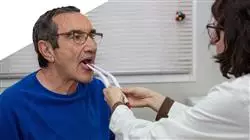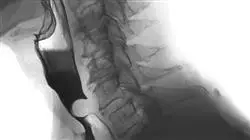University certificate
The world's largest faculty of medicine”
Introduction to the Program
With this 100% online Postgraduate diploma, you will gain access to specialized knowledge in the diagnosis, treatment, and intervention of Language and Communication Disorders, based on the latest scientific advances”

Neuroscience and Psychopathology of Language have experienced significant advances thanks to the integration of technologies such as functional neuroimaging and Artificial Intelligence. These tools have enabled a more accurate understanding of the brain mechanisms involved in language disorders such as Aphasia, Dyslexia, and Autism Spectrum Disorders (ASD).
This is how this Postgraduate diploma was created, whose content will include the study of the main structures of the central and peripheral nervous systems, with an emphasis on their role in communication processes. Likewise, the neurobiological bases of language and speech will be addressed, with an analysis of the brain areas involved in their production, comprehension, and motor control. The interactions between the sensory and motor structures responsible for speech production will not be overlooked, providing an anatomical and functional overview that is essential for clinical practice.
Physicians will also be trained in the use of diagnostic tests and in explaining advanced research techniques in language neuropsychology. In addition, the design of appropriate interventions will be encouraged based on the analysis of linguistic profiles and interdisciplinary data, ensuring comprehensive and personalized care for each case.
Finally, diagnostic assessment techniques and the preparation of comprehensive speech therapy reports will be explored in depth for intervention in various contexts, such as family, school, and clinical settings, using strategies and resources tailored to the needs of patients. This will also include the planning, implementation, and assessment of therapeutic programs that promote the improvement and recovery of affected language functions.
In this way, TECH has created a comprehensive 100% online program with materials and resources of the highest educational quality, accessible from any electronic device with an Internet connection. This will eliminate inconveniences such as traveling to a physical location or adapting to fixed schedules. Additionally, it will employ the innovative Relearning methodology, based on the constant repetition of key concepts to facilitate efficient and natural assimilation of content.
This Postgraduate diploma in Neuroscience and Psychopathology of Language will offer complete training to physician who wish to specialize in the neurobiological and clinical aspects of language disorders”
This Postgraduate diploma in Neuroscience and Psychopathology of Language contains the most complete and up-to-date scientific program on the market. The most important features include:
- Practical cases presented by experts in medicine
- The graphic, schematic, and practical contents with which they are created, provide scientific and practical information on the disciplines that are essential for professional practice
- Practical exercises where the self-assessment process can be carried out to improve learning
- Special emphasis on innovative methodologies in Neuroscience and Psychopathology of Language
- Theoretical lessons, questions to the expert, debate forums on controversial topics, and individual reflection assignments
- Content that is accessible from any fixed or portable device with an Internet connection
TECH offers you an innovative teaching methodology, aligned with the latest advances in the educational field”
Its teaching staff includes professionals from the field of medicine, who bring to this program the experience of their work, as well as renowned specialists from leading societies and prestigious universities.
The multimedia content, developed with the latest educational technology, will provide the professional with situated and contextual learning, i.e., a simulated environment that will provide an immersive educational experience designed to prepare students for real-life situations.
This program is designed around Problem-Based Learning, whereby students must try to solve the different professional practice situations that arise during the academic year. For this purpose, professionals will be assisted by an innovative interactive video system created by renowned and experienced experts.
This program offers you a wide variety of practical resources that will help you consolidate your theoretical knowledge”

A completely online program that allows you to study anytime, anywhere in the world”
Syllabus
This university program will cover key topics such as the anatomy and physiology of the nervous system, highlighting the structures and functions related to communication processes, motor control of speech, and the interaction between sensory and motor systems. It also explores the neurobiological bases of language and speech, providing an essential theoretical framework for the assessment and treatment of disorders in these areas.

The syllabus has been designed to enable you to understand and address Language Disorders from a neurobiological and clinical perspective, always with the support of the Relearning methodology”
Module 1. Anatomy and Physiology of the Nervous System
1.1. Introduction and Overview of the Nervous System
1.1.1. Definition and Functions of the Nervous System
1.1.2. Nervous System Classification
1.1.2.1. Anatomical Classification
1.1.2.2. Functional Classification
1.1.3. Evolution and Development of the Nervous System
1.1.4. Clinical Importance of Studying the Nervous System
1.2. Cellular Organization of the Nervous System
1.2.1. Main Types of Cells
1.2.1.1. Neurons
1.2.1.2. Glial Cells
1.2.2. Structure and Function of Neurons
1.2.2.1. Soma
1.2.2.2. Dendrites
1.2.2.3. Axon
1.2.3. Synapses and Neuronal Communication
1.2.4. Neurotransmitters and Receptors
1.3. Anatomical Organization of the Nervous System: Central and Peripheral
1.3.1. Central Nervous System (CNS)
1.3.1.1. Brain
1.3.1.2. Spinal Cord
1.3.2. Peripheral Nervous System (PNS)
1.3.2.1. Cranial Nerves
1.3.2.2. Spinal Nerves
1.3.2.3. Peripheral Ganglia
1.3.3. Connections between the CNS and PNS
1.4. Spinal Cord, Brain Stem, and Cerebellum
1.4.1. Spinal Cord
1.4.1.1. Anatomical Organization
1.4.1.2. Sensory and Motor Function
1.4.2. Brain Stem
1.4.2.1. Medulla Oblongata
1.4.2.2. Protuberance
1.4.2.3. Midbrain
1.4.3. Cerebellum
1.4.3.1. Anatomy of the Cerebellum
1.4.3.2. Functions of the Cerebellum
1.4.3.3. Cerebellar Connections
1.5. Diencephalon, Limbic System, and Basal Ganglia
1.5.1. Diencephalon
1.5.1.1. Thalamus
1.5.1.2. Hypothalamus
1.5.1.3. Epithalamus
1.5.2. Limbic System
1.5.2.1. Principal Components
1.5.2.2. Function in Emotions and Memory
1.5.3. Basal Ganglia
1.5.3.1. Anatomical Structures
1.5.3.2. Function in Motor Control
1.6. Cerebral Hemispheres
1.6.1. Cerebral Lobes
1.6.1.1. Frontal Lobe
1.6.1.2. Parietal Lobe
1.6.1.3. Temporal Lobe
1.6.1.4. Occipital Lobe
1.6.2. Hemispheric Functions
1.6.2.1. The Left Hemisphere
1.6.2.2. The Right Hemisphere
1.6.3. Cerebral Cortex
1.6.3.1. Sensory, Motor, and Association Areas
1.7. Vascularization of the Central Nervous System, Ventricular System, and Meninges
1.7.1. Vascularization of the CNS
1.7.1.1. Anterior Circulation: Carotid Arteries
1.7.1.2. Posterior Circulation: Vertebrobasilar System
1.7.1.3. Blood-Brain Barrier
1.7.2. Ventricular System
1.7.2.1. Cerebral Ventricles
1.7.2.2. Circulation of Cerebrospinal Fluid
1.7.3. Meninges
1.7.3.1. Dura Mater
1.7.3.2. Arachnoid Mater
1.7.3.3. Pia Mater
1.8. Spinal Nerves and Cranial Nerves
1.8.1. Spinal Nerves
1.8.1.1. Organization and Plexuses
1.8.1.2. Dermatomes and Myotomes
1.8.2. Cranial Nerves
1.8.2.1. Functions
1.8.2.2. Main Pathways
1.9. Neuromotor Control of Speech
1.9.1. Motor Pathways Involved
1.9.1.1. Pyramidal Pathway
1.9.1.2. Extrapyramidal Pathway
1.9.2. Brain Areas Related to Speech
1.9.2.1. Broca's Area and Supplementary Motor Area
1.9.2.2. Primary Motor Cortex
1.10. Neurological Principles of Language
1.10.1. Brain Structures Related to Language
1.10.1.1. Characterization of Broca's and Wernicke's Areas: Location and Specific Functions
1.10.1.2. Role of the Arcuate Fasciculus in the Connection Between Language Areas
1.10.1.3. Contribution of the Right Hemisphere in Non-Verbal Aspects of Language
1.10.2. Neural Processes in Language Acquisition and Production
1.10.2.1. Brain Plasticity and Its Influence on Language Acquisition
1.10.2.2. Neuronal Activation During Language Comprehension and Production
1.10.2.3. Participation of the Basal Ganglia and Cerebellum in Linguistic Processes
1.10.3. Neurological Disorders and Their Impact on Language
1.10.3.1. Types of Aphasia: Clinical Characteristics and Affected Areas
1.10.3.2. Language Disorders in Neurodegenerative Diseases (e.g., Alzheimer's, Parkinson's)
1.10.3.3. Impact of Traumatic Brain Injury on Language Function
Module 2. Neuropsychology of Language
2.1. Neuropsychology and Speech Therapy
2.1.1. Basic Concepts
2.1.1.1. Definition of Neuropsychology
2.1.1.2. Relationship between Neuropsychology and Speech Therapy
2.1.1.3. Cognitive Functions and their Relationship with Language
2.1.2. Assessment Methodologies
2.1.2.1. Neuroimaging Techniques
2.1.2.2. Neuropsychological Assessment of Language
2.1.3. Technique and Approach Route
2.1.3.1. Interdisciplinary Approach to Speech Therapy
2.1.3.2. Techniques for Neuropsychological Rehabilitation of Language
2.1.3.3. Speech Therapy Strategies for the Treatment of Cognitive and Communicative Disorders
2.2. Neuroanatomical Bases of Language
2.2.1. Brain Structures Involved
2.2.1.1. Broca's and Wernicke's Areas
2.2.1.2. Angular Gyrus and its Role in Reading
2.2.1.3. Temporal Lobe and Its Relationship with Comprehension
2.2.2. Brain Connections
2.2.2.1. Arcuate Fasciculus
2.2.2.2. Interhemispheric Connections
2.2.3. Left vs. Right Brain in Language
2.2.3.1. Hemispheric Dominance
2.2.3.2. Function of the Right Hemisphere in Non-verbal Language
2.3. Neurocognitive Processes of Language
2.3.1. Language Comprehension
2.3.1.1. Phonological and Lexical Decoding
2.3.1.2. Semantic and Pragmatic Comprehension
2.3.2. Language Production
2.3.2.1. Phonological Processing
2.3.2.2. Lexical, Syntactic and Semantic Processing
2.3.3. Memory and Language
2.3.3.1. Verbal Working Memory
2.3.3.2. Long-Term Memory and Language
2.4. Neuronal Plasticity and Language
2.4.1. Concept of Brain Plasticity
2.4.1.1. Definition and Types of Brain Plasticity
2.4.1.2. Factors Influencing Brain Plasticity
2.4.2. Mechanisms of Neuronal Plasticity
2.4.2.1. Synaptic Plasticity and its Role in Learning
2.4.2.2. Neurogenesis and its Implication in Brain Repair
2.4.3. Impact of Plasticity on Language Recovery
2.4.3.1. Adaptation Mechanisms in Language Disorders
2.4.3.2. Cortical Plasticity in Language Restructuring
2.4.4. Age and Plasticity
2.4.4.1. Effects of Early Age on Neuronal Plasticity
2.4.4.2. Plasticity in Adulthood and its Relationship with Language Learning
2.4.5. Brain Rehabilitation and Stimulation
2.4.5.1. Brain Stimulation Techniques for Language Rehabilitation
2.4.5.2. Speech Therapies and their Impact on Neuronal Plasticity
2.5. Neurobiological Language Disorders in Children
2.5.1. Speech Disorders
2.5.1.1. Speech Disorders
2.5.1.2. Childhood Apraxia
2.5.1.3. Childhood Dysarthria
2.5.2. Language Disorders
2.5.2.1. Specific Language Impairment (SLI)
2.5.2.2. Developmental Language Disorder
2.5.2.3. Simple Language Delay
2.5.3. Related Disorders and Neurodevelopmental Disorders
2.5.3.1. Acquired Childhood Aphasia
2.5.3.2. Autism Spectrum Disorder
2.5.3.3. Down Syndrome
2.5.3.4. Cerebral Palsy
2.6. Neuropsychological Assessment of Language in Children
2.6.1. Assessment Techniques
2.6.1.1. Standardized Tests
2.6.1.2. Clinical and Observational Assessment
2.6.2. Specific Neuropsychological Instruments
2.6.2.1. Verbal Fluency Assessment
2.6.2.2. Language Development Scales
2.6.3. Interpretation of Results
2.6.3.1. Analysis of Language Skills
2.6.3.2. Identification of Disorders and Comorbidities
2.7. Neuropsychological Rehabilitation in Children
2.7.1. Early Interventions
2.7.1.1. Language Therapy
2.7.1.2. Early Stimulation Approaches
2.7.2. Specific Therapeutic Approaches
2.7.2.1. Therapies Based on Games
2.7.2.2. Cognitive-Behavioral Therapy for Language
2.7.3. Rehabilitation Techniques
2.7.3.1. Brain Plasticity Therapies
2.7.3.2. Language Rehabilitation Using Technology
2.8. Neurobiological Language Disorders in Adults
2.8.1. Aphasia
2.8.1.1. Broca's Aphasia
2.8.1.2. Wernicke’s Aphasia
2.8.1.3. Global Aphasia
2.8.2. Disorders Related to Acquired Brain Injury
2.8.2.1. Dysarthria
2.8.2.2. Speech Apraxias
2.8.3. Neurodegenerative Disorders
2.8.3.1. Alzheimer's Disease and Language
2.8.3.2. Language Disorders in Amyotrophic Lateral Sclerosis (ALS)
2.8.3.3. Language Disorders in Parkinson's Disease
2.9. Neuropsychological Assessment of Language in Adults
2.9.1. Neuropsychological Tests in Adults
2.9.1.1. Assessment of Aphasias
2.9.1.2. Assessment of Cognitive and Linguistic Disorders
2.9.2. Diagnostic Methods
2.9.2.1. Clinical Interviews and Medical History
2.9.2.2. Functional Assessment Scales
2.9.3. Interpretation of Results in Adults
2.9.3.1. Assessment of Verbal Disfluency
2.9.3.2. Differentiation between Aphasia and Dementia
2.10. Neuropsychological Rehabilitation in Adults
2.10.1. Rehabilitation after a Cerebrovascular Accident (CVA)
2.10.1.1. Post-CVA Speech Therapy
2.10.1.2. Approaches Based on Neuroplasticity
2.10.2. Rehabilitation in Neurodegenerative Diseases
2.10.2.1. Intervention Approaches in Alzheimer's Disease
2.10.2.2. Language Rehabilitation in Amyotrophic Lateral Sclerosis (ALS)
2.10.3. Emerging Therapies
2.10.3.1. Cognitive-Behavioral Therapy in Aphasia
2.10.3.2. Use of Technologie for Language Rehabilitation
Module 3. Language Psychopathology
3.1. Introduction and Objectives
3.1.1. Concept and Fundamentals of Psychopathology of Language
3.1.1.1. Differentiation between Normal and Pathological Disorders
3.1.1.2. Historical Evolution of the Concept
3.1.1.3. Relationship between Language and Psychopathology
3.1.2. Concept and Classification of Language Disorders
3.1.2.1. Concept of Disorder, Impairment, Disturbance, and Delay
3.1.2.2. Classification of Language Disorders
3.1.3. Models in Psychopathology of Language
3.1.3.1. Biomedical and Rehabilitation Model
3.1.3.2. Biopsychosocial Model
3.1.4. Differentiating between Linguistic and Psycholinguistic Disorders
3.1.4.1. Primary vs. Secondary Language Disorders
3.1.4.2. Relationship with Other Psychological Disorders
3.2. Neurodevelopmental and Communication Disorders
3.2.1. Types of Communication Disorders
3.2.1.1. Expressive and Receptive Language Disorders
3.2.1.2. Verbal Fluency Disorders: Stuttering
3.2.1.3. Social Communication Disorder (Pragmatic)
3.2.1.4. Disorders of Voice and Articulation of Speech
3.2.2. Disorders of Speech Sounds in Children
3.2.2.1. Dyslalia
3.2.2.2. Childhood Dysarthria
3.2.2.3. Phonological Disorder
3.2.2.4. Changes in Articulation and Normal Speech Development
3.2.3. Simple Speech and Language Delay
3.2.3.1. Definition and Characteristics of Simple Language Delay
3.2.3.2. Assessment of Speech and Language Delay
3.2.3.3. Progression and Prognosis of Simple Language Delay
3.2.3.4. Risk and Protective Factors in Simple Delay
3.2.4. Explanatory Models
3.2.4.1. Cognitive Model and Its Application to Communication Disorders
3.2.4.2. Neurobiological Model of Speech and Language Disorders
3.2.4.3. Psychosocial Model
3.2.4.4. Interactive and Integrative Model
3.3. Neurodevelopment Disorders. Attention Deficit Hyperactivity Disorder
3.3.1. Conceptual Approach and Brief Historical Overview
3.3.1.1. Concept and Diagnostic Criteria for Attention Deficit Hyperactivity Disorder (ADHD)
3.3.1.2. Distinction Between ADHD, Impulsivity, and Behavioral Disorders
3.3.1.3. Etiology of ADHD: Genetic, Neurobiological, and Environmental Factors
3.3.1.4. Evolution of the Concept Throughout History
3.3.1.5. Early Diagnoses and the Transition to the Current Model
3.3.2. Classification and Clinical Manifestations
3.3.2.1. Classification of ADHD According to the DSM-5
3.3.2.2. Clinical Manifestations of ADHD in Children and Adolescents
3.3.2.3. Differential Diagnosis
3.3.3. Hyperactivity and Other Disorders
3.3.3.1. Hyperactivity Features in ADHD
3.3.3.2. Disorders Linked to Hiperactivity
3.3.3.3. Interventions and Treatments for Hiperactivity: Pharmacological and Behavioral
3.3.3.4. Educational Intervention
3.3.4. Impact of ADHD on Language Development
3.3.4.1. Difficulties in Language Comprehension and Expression
3.3.4.2. Disorders linked to Language Production
3.3.4.3. Intervention in Language Development in Kids with ADHD
3.3.5. Changes in Pragmatics and Verbal Fluency
3.3.5.1. Pragmatic Difficulties in ADHD
3.3.5.2. Verbal Fluency in ADHD
3.3.5.3. Treatment of Pragmatic and Verbal Fluency Disorders
3.4. Autism Spectrum Disorders (ASD)
3.4.1. General Conceptualization of ASD
3.4.2. Importance of Studying ASD in Speech-Language Pathology
3.4.3. Definition and Characteristics
3.4.3.1. General Characteristics of ASD
3.4.3.2. Early Signs and Progression
3.4.4. Classification
3.4.4.1. Diagnostic Criteria (DSM-5 and ICD-10)
3.4.4.2. Types of ASD: Mild, Moderate, and Severe
3.4.5. Psychopathology of Language in ASD
3.4.5.1. Communication and Language Difficulties
3.4.5.2. Pragmatic Language Disorders
3.4.5.3. Prosody and Syntax Disorders
3.5. Specific Learning Disorders
3.5.1. Concept and Classification of Neurodevelopmental Disorders
3.5.1.1. Relationship between Specific Learning Disorders and Other Neurodevelopmental Disorders
3.5.2. Definition and Characteristics
3.5.2.1. Definition of Specific Learning Disorders
3.5.2.2. Common Characteristics and Differences from Other Conditions
3.5.3. Types of Specific Learning Disorders
3.5.3.1. Dyslexia
3.5.3.2. Dyscalculia
3.5.3.3. Reading and Writing Learning Disorder
3.5.4. Explanatory Models
3.5.4.1. Neuropsychological Models
3.5.4.2. Cognitive Models
3.5.4.3. Environmental and Genetic Factors
3.6. Intellectual Disability, Sensory Impairments, Neurological Injuries, and Environmental Deprivation
3.6.1. Concept and Characteristics of the Intellectual Disability
3.6.1.1. Impact of Sensory Impairments and Neurological Injuries
3.6.1.2. Definition and Characteristics of Intellectual Disability
3.6.2. Diagnostic Criteria and Levels of Disability
3.6.2.1. DSM-5 and ICD-10 Criteria for the Diagnosis of Intellectual Disability
3.6.2.2. Levels of Disability and Their Implications for Treatment
3.6.3. Explanatory Models of Intellectual Disability
3.6.3.1. Genetic and Neurological Models
3.6.3.2. Environmental and Cultural Approaches
3.6.4. Assessment of Intellectual Disability
3.6.4.1. Diagnostic Tools and Their Application
3.6.4.2. Early Intervention Strategies
3.6.5. Cerebral Palsy, Blindness, Deafness, and Social Isolation
3.6.5.1. Repercussions of Cerebral Palsy on Motor and Cognitive Development
3.6.5.2. Impact of Blindness and Deafness on Language Acquisition
3.6.6. Effects of Sensory Impairments on Language Development
3.6.6.1. Cerebral Palsy and its Relationship to Language
3.6.6.2. Interventions to Improve Communication in Sensory Impairments
3.6.7. Social Isolation and its Impact on Communicative Development
3.6.7.1. Effects of Social Isolation on the Acquisition of Communication Skills
3.6.7.2. Strategies to Promote Social and Communication Integration
3.7. Psychopathology in Personality Disorders and Psychotic Disorders
3.7.1. Definition of Personality Disorders and Psychotic Disorders
3.7.1.1. Relationship with Language and Communication
3.7.1.2. Personality, Characteristics, and Classification of Personality Disorders
3.7.2. Personality Disorders
3.7.2.1. Borderline Personality Disorder
3.7.2.2. Narcissistic and Antisocial Disorder
3.7.2.3. Avoidant and Dependent Disorder
3.7.2.4. Language Disorders in Personality Disorders
3.7.3. Schizophrenia and Other Psychotic Disorders
3.7.3.1. Characteristics of Schizophrenia
3.7.3.2. Other Psychotic Disorders (Schizoaffective Disorder, Delusional Disorder)
3.7.3.3. Language Disorders in Psychotic Disorders
3.7.3.4. Hallucinations and Their Impact on Language
3.8. Psychopathology of Language in Other Clinical Conditions and Consequences for the Environment
3.8.1. Relationship between Psychopathology and Language Disorders in Different Clinical Conditions
3.8.2. Consequences for the Social and Family Environment
3.8.3. Depression and Mania
3.8.4. Characteristics of Affective Disorders
3.8.5. Effects of Depression and Mania on Language
3.8.6. Language Disorders in Affective Disorders
3.8.7. Anxiety Disorders
3.8.7.1. Types of Anxiety Disorders (Generalized, Phobic, Social)
3.8.7.2. Impact of Anxiety on Language
3.8.7.3. Language Disorders in Anxiety Disorders
3.8.8. Dementia and Language Disorders
3.8.8.1. Effects of Dementia on Language (Aphasia, Apraxia)
3.8.8.2. Treatment and Management of Language Disorders Associated with Dementia
3.8.8.3. Family, School, and Social Environment in Psychopathology of Language
3.9. Impact of Language Disorders on Child and Adolescent Mental Health
3.9.1. Relationship between Language Disorders and Mental Health in Childhood and Adolescence
3.9.1.1. Importance of Early Diagnosis and Intervention
3.9.1.2. Language Disorders and Emotional Development
3.9.1.3. Effects of Language Disorders on Self-Esteem and Self-Confidence
3.9.1.4. Impact on Social Skills and School Integration
3.9.2. Language Disorders and Anxiety Disorders
3.9.2.1. Relationship between Communication Difficulties and Anxiety Disorders in Children and Adolescents
3.9.2.2. Linguistic Manifestations Associated with Anxiety (Evasion, Incoherence, Among Others)
3.9.3. Language Disorders and Depressive Disorders
3.9.3.1. Effects of Language Disorders on the Development of Depression in Children and Adolescents
3.9.3.2. Linguistic Characteristics of Depressive Disorders (Monotonous Speech, Reduced Vocabulary, etc.)
3.9.4. Language Disorders and Behavioral Disorders
3.9.4.1. Relationship between Language Difficulties and Behavioral Disorders in Children and Adolescents
3.9.4.2. Influence of Communicative Frustration on Disruptive Behaviors
3.10. The Role of Speech Therapists in the Rehabilitation of Patients with Schizophrenia and Language Disorders
3.10.1. The Impact of Schizophrenia on Language and Communication
3.10.1.1. The Importance of Language Rehabilitation in Schizophrenic Patients
3.10.1.2. Linguistic Characteristics in Schizophrenia
3.10.1.3. Impairments in Language Fluency, Coherence, and Structure
3.10.2. The Role of the Speech Therapist in Diagnosis and Assessment
3.10.2.1. Language Assessment Tools for Patients with Schizophrenia
3.10.2.2. Identification of Associated Language Disorders (Aphasia, Dysarthria, etc.)
3.10.3. Speech Therapy Intervention in Schizophrenia
3.10.3.1. Therapies Aimed at Improving Verbal and Non-Verbal Communication
3.10.3.2. Techniques for Restructuring Speech and Improving Fluency
3.10.3.3. Interventions in Prosody, Syntax, and Semantic Disorders
3.10.3.4. Treatment of Speech Disorders in Schizophrenia
3.10.3.5. Strategies for Treating Dysarthria and Mutism
3.10.4. Interdisciplinary Work in Schizophrenia Rehabilitation
3.10.4.1. Collaboration between Speech Therapists, Psychiatrists, and Psychologists for a Comprehensive Approach
3.10.4.2. Assessment of the Social and Family Environment and Its Impact on Language Rehabilitation
3.10.4.3. Prognosis and Monitoring

Bet on TECH! You will address the interactions between the motor and sensory structures involved in speech articulation, facilitating a comprehensive understanding for the diagnosis and treatment of disorders”
Postgraduate Diploma in Neuroscience and Psychopathology of Language
Language and communication disorders are increasingly recognized as key areas for improving the quality of life of those who suffer from them. These disorders not only affect verbal expression, but also have profound implications for thinking, social interaction, and emotional well-being. In this context, TECH's Postgraduate Diploma in Neuroscience and Psychopathology of Language is designed to provide health professionals with the tools to understand and treat neurological language disorders. With a comprehensive approach that encompasses both neuroscientific and psychological aspects, this program is a solution for those who wish to specialize in this constantly evolving field. In addition, the latest research in language neuroscience will be addressed, delving into the brain mechanisms involved in language processing and production.
Take an advanced study of neurological language disorders
This Postgraduate Diploma, complemented by the Relearning methodology, will address in detail neurological disorders that affect language, including aphasia, dysarthria, speech apraxia, and other related pathologies. Throughout the program, specialists will analyze the clinical implications of these disorders, including best practices for assessment, diagnosis, and therapeutic intervention. In addition, they will address key aspects such as the use of neuroplasticity to promote the recovery of linguistic functions and psychological interventions associated with speech recovery. Finally, they will master the interdisciplinary work necessary to treat patients in a comprehensive manner, considering neurological, psychological, and social factors. This holistic approach will help participants develop skills to design individualized and effective treatment plans, always with an ethical and humanistic approach. In short, graduates will be highly skilled in addressing the challenges presented by neurological language disorders, improving the quality of life of their patients and contributing to the advancement of the field.







